What does digital transformation mean for business?
“There is no reason for anyone to want a computer in his home.” — Ken Olson, CEO and pioneer of Digital Equipment Corporation (DEC) in the USA in 1977
Fast-forward to digital transformation, and there are billions of PCs and smartphones in homes with access to the internet.
Digital transformation has become a part of every aspect of business. Let’s discover what digital transformation is in detail.
What is digital transformation in business? Examples in different industries
In the business context, digital transformation means upgrading from older (traditional) technology to newer technology to create value in an ever-changing digital economy.
Here’s how different industries benefit from digital transformation:
Healthcare: Healthcare providers have adopted technology to reduce the time involved in processes such as generating patient reports, analyzing risks, assisting patients, reducing infrastructure costs, and getting quicker health analysis and alerts.
Retailers: Digital transformation benefits retailers by driving agility in their business processes, enhancing the customer experience, reducing operational costs, automating tedious tasks, and more.
Hospitality: Digital solutions improve customer service through online bookings, self-service, smart seasonal offers, etc.
Manufacturing: Digital transformation enables manufacturers to meet increased customer expectations, the need for connectivity and technological improvements, and disruption. Smart manufacturing, data-driven risk analysis, and data-driven decision-making bring more safety to the workplace.
What does this mean for the workforce?
The greatest challenge is not adopting the technology but developing a knowledgeable, engaged, and efficient workforce. The question is whether your workforce possesses the skills essential to leverage these new technologies.
Emerging technologies require HR leaders to be the best advocates for both the workforce and the organization to create more healthy, competitive, and successful ecosystems. Before looking into how major companies have benefited from digital transformation, let’s dive into the key drivers accelerating this growth.
Key drivers of digital transformation
5G telecommunications
Salvador D’Itri, Chair of the National Spectrum Consortium, estimates that the advent of 5G will create about 4.6 million jobs in the technology sector. With the telecom industry taking the maximum advantage of 5G, there will be massive demand for new telecom-related skill sets, covering wide-ranging cloud-based security, machine learning, big data, and IoT development skills.
The Internet of Things (IoT)
Heard of Fitbit, Tesla, and iRobot? These companies provide real-world examples of the Internet of Things (IoT), an ecosystem that connects information with little or no human assistance through wearable, implantable, or portable technology.
According to a report by Mordor Intelligence, the IoT market confirmed a growth to $761.4 billion in 2020 and is expected to reach $1.39 trillion by 2026. Depending on the company and the type of IoT role, prospective candidates may require experience with technologies such as AWS, Python, machine learning (ML), big data, the blockchain, and artificial intelligence (AI).
Artificial intelligence
Artificial intelligence (AI) is no longer just the idea of a futuristic world resembling science fiction movies. The line between reality and fiction has blurred. AI is changing the world and people’s lives and is becoming the engine of growth for economies and organizations.
To keep up with the pace of AI, employees will need to align with the following skill sets:
- Data analytics skills, including predictive modeling, demand forecasting, customer segmentation, cross-selling/upselling, and dynamic pricing
- Natural language processing, such as for machine translation and speech tagging
- Robotic automation to help collect, interpret, and extract knowledge for communication and automated processing
Take a look at how different industries are using artificial intelligence.
Cloud computing
The number of people working remotely has grown since the pandemic began. While people sought more flexible work opportunities, cloud-based workforce management allowed just that. It enables employees to work from anywhere, from any device, at any hour during the day. On the other hand, it allows organizations to oversee the functioning of all departments.
According to a study by Wang Jin, a researcher at the MIT Initiative on the Digital Economy, “the adoption of cloud is associated with about 6.9% higher sales in the long run.”
When the need for cloud services increases, it’s natural that the demand for cloud-related skills will increase as well. Cloud computing enables demand for skills such as operational agility, flexibility, effective data-driven decision-making, security, and task management.
Below are some of the top emerging cloud skills needed in the future.
Source: CompTIA
Key benefits of digital workforce transformation
Positive impact on workforce productivity
The most commonly stated benefit of automation is that it eliminates the risk of human errors. Secondly, it improves employees’ productivity, as employees get more done by eliminating mundane tasks. For example, a cloud database eliminates the long process of searching for a particular file in the cabinet or the fear of losing information.
Coca-Cola used to expect a paper ticket from employees as proof of delivery. However, this would lead to chaos, as sometimes employees would misplace the tickets and spend lots of time looking for them or keeping records. So Coca-Cola introduced a digital traceability system to digitize the proof of delivery process and streamline operations.
By doing this, Coca-Cola avoided wasting valuable employee time spent looking for tickets and was able to focus on more productive tasks.
Enhanced customer experience
The digital era brought a new wave of competition. Organizations are essentially digitalized and embraced technology to meet customer needs. However, customers’ demands have now increased. For example, fast-food chains can no longer compete on instant delivery of goods, as customers are already used to that. They are now experiencing customer experience gaps as they consistently try to meet the rising customer expectations.
McDonald’s realized the growing gap between what their customers expected and what was delivered. They decided to focus on the customer experience by introducing digital technology such as interactive ordering units, AI-powered drive-thru points, and a smart mobile app. Digital transformation has helped McDonald’s reduce the customer experience gap and still retain its position as one of the top fast-food chains, even post-pandemic.
Increase in revenue
Organizations that do not keep up with digital transformations face the prospect of losing their footing in the market due to the threat of digital disruption. For example, The New York Times found itself in a tight spot when the popularity of newspapers waned due to the widespread digitization of content.
The New York Times launched a simple article-hosting website in 1996 that they have since successfully transformed into what is now a highly profitable multimedia platform. The newspaper gained an advantage over competitors by executing the right technological strategies.
The result? The New York Times’s total subscription revenues increased by 11 percent, with digital-only subscription revenue growing to 23 percent in 2022.
Increase employee learning retention and engagement
The foundational pillar of digital transformation is digital literacy. When employees are confident that they have the proper knowledge to use new technology, they’re keener to use it to improve their efficiency. Therefore, digital upskilling plays a critical part in the success of every organization.
To keep up with the required digital skills, the US Air Force crafted 24/7 access to learning platforms focused on data science, the cloud, programming, and UX. After six months of implementing the program, the Air Force received positive results: 45% of employees took on more significant roles than their current ones, and 10% moved to new roles, filling critical digital gaps
Strengthen your workforce for digital transformation
Find out through the infographic how you can empower your workforce with modern tools and technologies to meet organizational objectives integral to your digital transformation strategy.
Getting started on digital workforce transformation
Below are the different phases that can help HR leaders drive towards digital transformation.
Digital resources — highlight the most essential assets and capabilities needed for digital transformation
The first step to consider is understanding the needs of digital assets like data storage, information infrastructure, and accompanying technologies.
Identify relevant digital resources you need to transform your business digitally. Moreover, think about employee training to boost digital literacy or teach more advanced competencies like programming skills.
Organizational structure — consider the organizational changes needed to adapt to digital change
Another vital issue to consider is the organizational changes needed to adapt to digital change. Using a standard top-down approach may no longer be effective in fast-changing digital environments, as it reduces response speed and the ability to innovate.
Most notably, the IT department must focus on enabling communication lines into a more proactive and supportive function. However, organizations often do not realize that — apart from changing the functional role of the IT department — employees’ digital skills in marketing, operations, and other departments also need to be upgraded to enhance value creation. Value creation is the process of using the current manpower and resources to create more value for the business, employees and customer.
From an HRM perspective, digital transformation implies attracting employees with digital and analytical skills that may replace the existing workforce or setting up proper upskilling, reskilling, and cross-skilling programs to prepare current employees for the future.
Digital transformation becomes imperative to every company’s survival. However, not every business leader knows what kind of transformation they need, how to accomplish this transformation, or where to start. Whether finding the right tech, managing change, or training your people, we can help you reimagine your HR and business processes. Contact our team to discover our products and the HR challenges you can solve with them.
Stay up to date with our newsletter
Every month, we’ll send you a curated newsletter with our updates and the latest industry news.





























 info@hrforecast.de
info@hrforecast.de
 +49 89 215384810
+49 89 215384810






